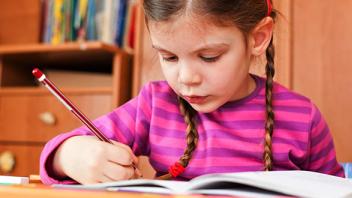A child’s writing development parallels the child’s development as a reader. Part of early print awareness is the realization that writing can be created with everyday tools such as pens, pencils, crayons, and markers. Children begin to imitate the writing that they see in the environment. What often starts as scribbling ends up being important clues to a child’s understanding that print carries meaning. Young children often mirror what they see around them; adults and older children writing lists, notes, text messaging. They are observing the way writing is used in our everyday lives.
As preschoolers get a bit older, they begin to understand that writers use symbols to convey their meaning. Writing begins to include shapes (circles, squares) and other figures. A child will often write something and ask, “What does this say?”
Pre-K children start drawing letter-like shapes in a large circular motion as a playful activity. Often, a young child’s first letters are drawn by accident and then identified by the child or parent.
First marks
Writing expert Dr. Jane Hansen describes how powerful it is for very young children to realize that they can communicate through oral language — and by making “marks” on a piece of paper.
Emergent writing
Let’s watch classroom teachers demonstrate effective writing instruction for young children in this video by the Northeast Florida Educational Consortium.
Letting your children scribble gets them ready to read and write
This video is from Home Reading Helper, a resource for parents to elevate children’s reading at home provided by Read Charlotte .
More on early writing
Looking at Writing
Looking at Writing: Pre-K
Reading 101: A Guide for Parents
Writing Activities for Your Pre-K Child
Preschool and Child Care
How Do I Write…? Scaffolding Preschoolers’ Early Writing Skills
Preschool and Child Care





